Original Superior Jazz Band, Sept. 1962
Subbing for Goulette on this session was cornet player Ev Farey, demonstrating his good taste and skill in both solo and ensemble passages. They step lively through “South,” a staple of the Traditional Jazz repertoire. Despite an awkward ending the charming group vocal of “Bill Bailey” could not be omitted.
Everyone shines in a grand rendition of “Black and Blue.” It demonstrates why trombone player Bill Bardin (1929-2011), who was comfortable in either two-beat or four-beat style, was held in awe by his contemporaries. Though this was not a two-horn band, cornetist Ernie Carson dropped by adding a second horn. Johnny Dodds-inspired clarinetist John Boland shines on “Cakewalkin’ Babies” which, though incomplete, contains a crackerjack horn duet.
“Come Back Sweet Papa” is a nicely voiced tribute to their spiritual and musical predecessor: the Yerba Buena Jazz Band. Remaining in two-horn mode, they push full–throttle through “Snake Rag” for a double-barreled finish.
South – Original Superior Jass Band.mp3
Bill Bailey – Original Superior Jass Band.mp3
(What Did I Do to Be So) Black and Blue – Original Superior Jass Band.mp3
Cakewalkin’ Babies – Original Superior Jass Band.mp3
Come Back Sweet Papa – Original Superior Jass Band.mp3
Snake Rag – Original Superior Jass Band.mp3
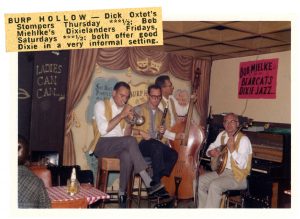
Quartet version of Dick Oxtot’s Stompers with Ted Butterman (cornet), Bunky Colman (clarinet), Pete Allen (bass) and Oxtot (banjo). The San Francisco Chronicle Datebook rated Burp Hollow three and a half stars — between ‘Laudable’ and ‘Memorable.’
The Ubiquitous Dick Oxtot
Dick Oxtot (1918-2001) was a bandleader and vocalist who played banjo, cornet and bass (tuba and string bass). An excellent gig getter, he was heard all over San Francisco and the Bay Area leading bands, sitting in, or anywhere Bob Mielke and The Bearcats deployed. Personnel rosters were fluid for his ensembles, known in the early days as the Polecats and later as Dick Oxtot’s Stompers. This lineup was essentially Mielke’s Bearcats with their swinging four-beat rhythm orientation.
In San Francisco, Oxtot also ran notable sessions several nights a week at The Bagatelle over on Polk Street. On Sunday afternoons he featured Louisiana-born African American clarinet players Frank “Big Boy” Goudie or Clem Raymond. “Uncle Dick,” aka “The Silver Fox” could be found sitting-in at Pier 23 jam sessions on the nearby waterfront. And he ran a Folk Music harmony trio that was successful enough to have once opened for a famous comic at the hungry i nightclub a few steps away.
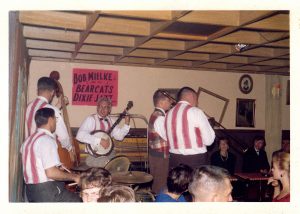
Oxtot Bearcasts Six. On the back of this photo is noted in Oxtot’s hand: “The personnel of the Bearcats and Polecats are often the same, depending on who gets the gig – Mielke or me! This Burp Hollow job has Don Marchant, Pete Allen, me, Bill Erickson and Bob Mielke.” Clarinetist Napier is no doubt present but not visible.
Dick Oxtot’s Stompers, 1959
This ensemble wasn’t merely The Bearcats under Dick’s leadership but had a chemistry of its own. Mielke played only a supporting role, despite owner Militti’s ongoing intentional misuse of his name. The arrangements were simple, basically a series of solos with some riffing and lively ensemble ride-out choruses.
Trumpeter Bill Erickson and clarinetist Bill Napier were featured. Oxtot and bassist Pete Allen supplied the classic Bearcats rhythm element. The drummer was most likely Max Leavitt. Not usually part of this posse, it’s probably his sly blues vocal on “Blues Jumped A Rabbit.”
Back in Your Own Back Yard – Dick Oxtot’s Stompers.mp3
Bugle Boy March – Dick Oxtot’s Stompers.mp3
Blues Jumped A Rabbit – Dick Oxtot’s Stompers.mp3
Song of the Islands – Dick Oxtot’s Stompers.mp3
1919 March – Dick Oxtot’s Stompers.mp3
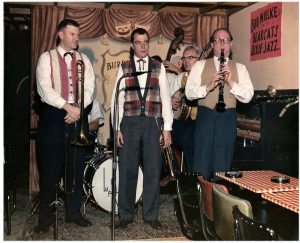
Dick Oxtot’s Stompers wearing the despised vests required by management: Bob Mielke, Bill Erickson, Pete Allen, Dick Oxtot and Bill Napier, c. 1959.
Bill Erickson Leading the Ensemble
The loosely structured group was co-led musically by trumpet player Bill Erickson (1929-1967). Erickson developed a clear personal voice on trumpet in his own hard-to-categorize style. He was neither selfish nor shy, didn’t show off and paired up for riffs behind the soloists. He offered clear direction, supported the ensemble and loved ‘trading fours’ (two or more musicians swapping solos every four bars).
Playing trumpet was only a small measure of his talents. “Willie the Master” was best-known as a local piano player leading combos and jam sessions on both sides of the Bay, most notably at Pier 23 several nights a week. Erickson’s shocking suicide in 1967 and lack of a recorded legacy have conspired to obscure the memory of his lost genius. This is first publication of him playing trumpet since the 78 rpm era. (Erickson is heard on several titles from Frisco Jazz Archival Rarities and Grammercy Records.)
“Back in Your Own Back Yard” illustrates Erickson’s clean technique and declarative execution. Louis Armstrong introduced the gentle “Song of the Islands” to jazz in 1930. Having a decent ensemble rendition of “1919 March” was simply obligatory for any self-respecting revival band of the era.
Clarinetist Bill Napier
If there is a star of this ensemble, it was clarinet player Bill Napier (1926-2003). Given generous solo time on almost every tune he made eloquent statements in a range of moods. His daring variations were surprisingly delicate, risky improvisations teetering on the precipice of disaster that never fail.
Napier was a brilliant hot jazz musician whose primary influences were reed players Jimmy Dorsey and New Orleans natives Barney Bigard, Omer Simeon and Albert Nicholas. Napier was among the finest clarinetists produced by the Frisco revival, playing imaginative parts with vivid tone colors. Owlish and self-contained, he was close with Mielke and these musicians for more than 50 years.
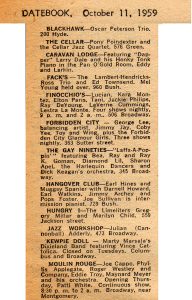
A typical San Francisco Chronicle listing of jazz and entertainment in North Beach and environs, October 1959.
Echoes of mid-Twentieth Century North Beach
From 1956-66, a generation of young jazz musicians in and around San Francisco were intensively engaged in reviving, reinventing and advancing America’s most original art form. North Beach was jumping with nightspots offering a wide range of styles: Mainstream, Modern, Dixieland and Traditional Jazz.
Hidden among the popular brand-name nightclubs like Copacabana, Purple Onion, El Matador and Macumba was a thriving musical ecosystem sustained by a surplus of excellent musicians, eager young fans and dives like Burp Hollow. Within walking distance were half a dozen famed spots oriented exclusively to Dixieland or Traditional jazz: Club Hangover, Earthquake McGoon’s, On the Levee, Sail ‘N and Pier 23. Just across the street was Sugar Hill run by singer Barbara Dane, one of many folk-oriented clubs in the neighborhood.
In 1959 Jazz was booming in North Beach and spilling into nearby neighborhoods.
But during the late-1960s and into the 1970s, music venues in North Beach gave way to strip joints and Topless bars, comedy clubs or tourist traps, and increasingly — Rock music. The distinctive and once widely popular Frisco Jazz sound became an endangered species surviving only in niches like Earthquake McGoon’s Club, Pier 23 or a few select jobs at the big San Francisco hotels.
The formation of jazz societies like New Orleans Jazz Club of Northern California became necessary to sustain a habitat. The musicians continued playing the music they loved for decades though, sadly, they’re almost all gone now. Fans and musicians easily forgot about Burp Hollow and the beer-and-peanuts joints of that ilk with their sawdust-covered floors.
But thanks to a handful of surviving tapes and photos we can revisit North Beach c. 1960. Where, at a crowded little gingham-topped table, hosted by a shady operator and presided over by a comely manikin, the best of Frisco Jazz was served up with a dubious cocktail at the infamous Burp Hollow.
Based on interviews, correspondence or discussions with Ted Butterman, Ev Farey, Dave Greer, Bob Mielke and Earl Scheelar who provided audio, photos and clippings from their personal collections. Original Inferior/Superior audio recording made by Ed Sprankle. Thanks to Hal Smith for music consultation.
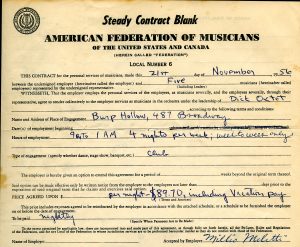
Oxtot and Militti’s union contract specified a band of five musicians playing 9:00 p.m. to 1:00 a.m. four nights a week, to be paid nightly.
- ← Previous page
- (Page 2 of 2)

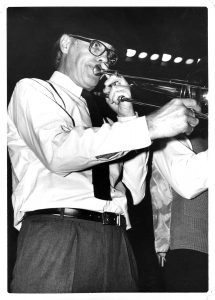
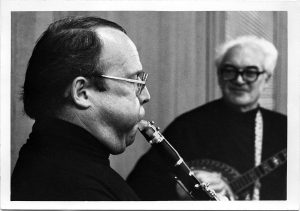

The story of Burp Hollow and classic jazz continue at the Jazz Rhythm website:
http://jazzhotbigstep.com/104.html
Burp Hollow http://jazzhotbigstep.com/400333.html
Dick Oxtot http://jazzhotbigstep.com/486423.html
Bill Erickson http://jazzhotbigstep.com/249912.html
Ev Farey http://jazzhotbigstep.com/773265.html
Bill Napier http://jazzhotbigstep.com/400312.html
Nice work, Dave
There were also plenty of smaller bands at Burp Hollow some of which I played in around 1959-60: Oxtot’s smaller (not Watters) configurations, like Walt Yost on tuba, Oxtot banjo and vocals or cornet, me on clarinet, and wonderful Bill Erickson on piano. Once, when we were late by 2 minutes getting back to the stand after a break, Emilio barked over customers’ heads across the room, “Hey Oxtot! You guys want to keep working here or not?”
A great article, Dave. I remember being there at Burp Hollow and also playing with Frank G. at the Honeybucket. I did some recording while there and put out a cd Tradjazz Productions TJP 2141 which is still available. Wish those days still existed!
Thanks for your jaded memories of The Burp.
Max Leavitt says it he wasn’t the vocalist on “Blues Jumped a Rabbit”.